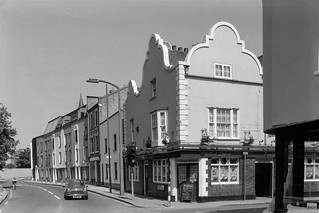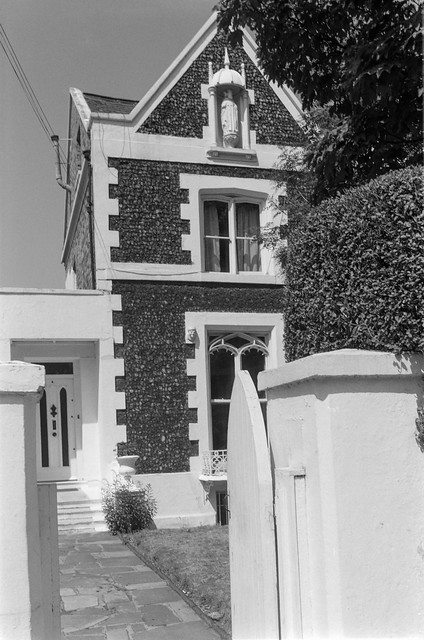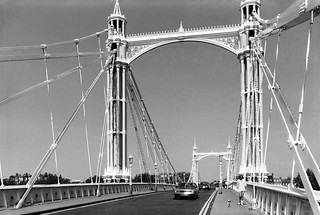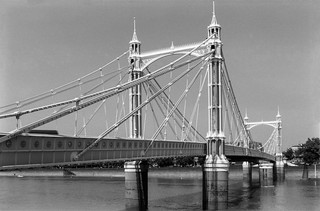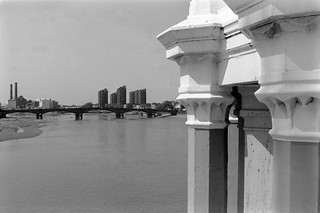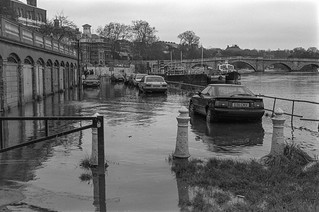The Raven, Villas, Mansion Flats & A Bridge continues my walk on Friday 4th August 1989 in Battersea which began with the previous post, Council flats, Piles of Bricks, A House Hospital and Brasserie.
Also at the edge of Battersea Square, on the corner of Battersea Church Street and Westbridge Road is The Raven pub, probably the most significant building in the area, built here in the mid seventeenth century and open as the Black Raven in 1701. Grade II listed it has had various alterations since then but is the only remaining pre-Victorian building in the area. Its value was recognised by a very early listing made in 1954, although it had been extenisvely rebuilt in 1891
Unfortunately this is no longer a pub, but Melanzana, a independent ‘bar-trattoria-deli‘ which according to Camra no longer serving any real beer. You can drink Peroni or wine with your pizza or pasta. I don’t think its interior retains anything of historic interest.
Another image about gentrification. I’d walked back east along Westbridge Road towards Battersea Bridge Road. I think this house was being converted into four flats. This was a significant area of early middle class development in the area in the 1840s with villas with long rear gardens in contrast to the much more downmarket development of what was rapidly becoming an industrial area.
This and its neighbour at 2 Westbridge Road are a pair of Grade II listed Gothic villas dating from 1845, just a few yards from the junction with Battersea Bridge Road. They are included in the Westbridge Road Conservation Area, much of which was developed by 1865. The appraisal describes them as “napped flint faced Gothic villas, quite unique in the district” and gives a further description of them along with a photograph from across the street taken in winter.
In August when I made my picture the houses were largely hidden by the leaves on the trees in their garden. But my view through the open gate does show the statue in the niche at the top of the building more clearly. The pair of houses also have an unusual front wall and gates.
A number of blocks of mansion flats were built in the 1890s on the edges of Battersea Park along Prince of Wales Drive and Albert Bridge Road, their position with views across of the park making them attractive to wealthier middle-class tenants who needed to live close to the West End. Chelsea was too expensive but this area was only just south of the river and not really in those dangerous areas where posher Londoners (and taxi drivers) feared to go. Apparently adverts for some of the new blocks gave their address as Chelsea Reach, Battersea – estate agents today are still often rather inventive in their descriptions of locations.
According to the Survey of London, almost 1,000 apartments were built here between 1892 and 1902.
The development here was suggested by architect and property speculator John Halley, who had moved south to London from Glasgow in the 1880s and had already put up blocks in Kensington. His plans were too dour for London, resembling Glasgow’s tenements, and he teamed up with another architect William Isaac Chambers who pimped them up for London tastes, though other architects made changes too as The Survey of London article recounts.
Cranbourne Court was one of the last blocks to be built, with Halley again involved along with one of his earlier co-developers, Captain Juba Page Kennerley, “a colourful character who had dabbled in a variety of dubious money-making schemes” and who was “indicted for theft and declared bankrupt” in the early 1890s. An undischarged bankrupt, he had set up a building company under an alias ‘Cranbourne & Cranbourne’ who built this block in 1895.
Albert Bridge is a curious mixture, built as a modified cable-stayed bridge using the system patented by Rowland Mason Ordish and William Henry Le Feuvre in 1858. This made use of a normal parabolic cable to support the central span of the bridge but used inclined stays attached to the bridge deck and connected to the octagonal support columns by wire ropes to support the two ends of the load. Ordish’s designs, made in 1864, were only built in 1870-3.
When the Chief Engineer of the Metropolitan Board of Works Sir Joseph Bazalgette inspected in the bridge in 1884 he found corrosion of the staying rods had made the bridge unsafe and he added steel chains and a new timber deck.
In 1972 the bridge was again found to be unsafe, and the LCC added two concrete piers to support it in mid-river, turning the central section into a beam bridge, though the earlier cables and stays remain in place.
This was one of London’s earlier wobbly bridges (along with Battersea Bridge) and because of its closeness to Chelsea barracks a notice was attached to this “Albert Bridge Notice. All troops must break step when marching over this bridge.” It was feared that troops marching in unison could set up a resonance such as that which had been blamed for the collapse of the Broughton Suspension Bridge in Salford in 1831. The notices now on the tollboths date from 1965 but are said to be replacements of earlier notices on the bridge.
The view upstream from the bridge across the River Thames past Battersea Bridge to tower blocks on the 1970s World’s End Estate and the Lots Road Power Station.
I walked on into Battersea Park where the next post about my walk will continue.
Flickr – Facebook – My London Diary – Hull Photos – Lea Valley – Paris
London’s Industrial Heritage – London Photos
All photographs on this page are copyright © Peter Marshall.
Contact me to buy prints or licence to reproduce.
